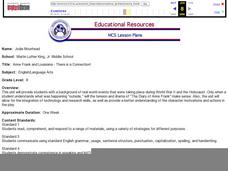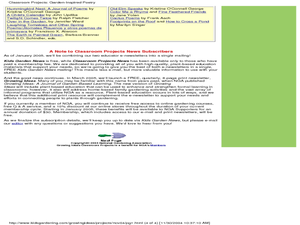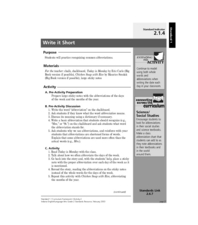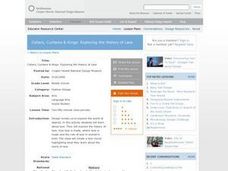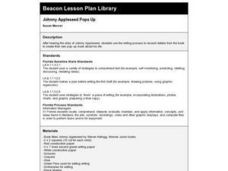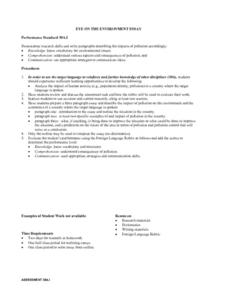Curated OER
Women Call Out: The Personal Narrative
After reading and discussing several personal narratives written by women in the 1920's, class members write a personal narrative of their own about a time in their lives they felt controlled. Sample narratives can be accessed through...
Curated OER
Anne Frank and Louisiana - There is a Connection!
How is Louisiana connected to the Holocaust? After reading The Diary of Anne Frank, eighth graders complete a research report about a survivor of the Holocaust who currently resides in Louisiana. Though the idea is a good way to...
Curated OER
Growing Poems
Young scholars write garden inspired poetry. In this poetry lesson plan, students go out into the garden and write poems about how they feel, what they see, and what is going on in the garden.
Curated OER
Toilet to Tap?
Students answer the question, 'Should San Diego reclaim its water for fresh drinking water?' They make a poster explaining the position: "Yes," drink reclaimed water; or "No," don't drink reclaimed water.
Curated OER
Can You Find It?
Fourth graders discover how to do an Internet search. They reviewi traditional rescources used to find answers in the classroom and are introduced to electronic sources. They discuss terminology for navigating the Internet using the...
Curated OER
Irregular Fractals
Students explore the concept of irregular fractals. In this irregular fractals lesson, students discuss how to find fractal dimensions through teacher led discussion. Students calculate fractal dimensions of various fractals.
Curated OER
Favorite Activity
Students write persuasive essays about favorite activities. They present on a topic of personal interest or one that has been studied in another subject area. They write a composition of a favorite activity, describing the activity and...
Curated OER
Write It Short
Students listen the books, "Today Is Monday," "Chicken Soup with Rice," and discuss how we use abbreviations for days of the week. This simple lesson is a good way to introduce the common abbreviations that young readers will encounter...
Curated OER
Unearthing The Facts
Students use agriculture related questions in order to build research skills. The questions are given and then they are expected to determine the best resource for finding the answers. The connection to the farmer is how they use...
Curated OER
CDV, CDV, What's a CDV?
Introduce your class to the Core Democratic Values. The instructional activity focuses on defining the Core Democratic Values and related terms. Small groups look up terms and present a song based on the information they've found. After...
Curated OER
Haunting Music
Students discover music that was inspired by the spooky and bizarre. In this music of Hector Berlioz and Camille Saint-Saens lesson, students identify elements of music and listen to the Symphonie Fantastique and Danse Macabre....
Curated OER
Bird Up
Third graders identify basic physical and behavioral characteristics of birds and how they adapt to their environments. To organize and share scientific information with peers. They discuss similarities and differences among birds....
Curated OER
Histograms and Bar Graphs
Students examine the use of bar graphs and histograms. In this data representation lesson plan, students investigate the proper use of bar graphs and histograms to represent data. They learn the proper geometric definitions, experience...
Curated OER
Jamestown's Economy
Students identify items made in Jamestown and draw conclusions about their economy. In this Jamestown economy lesson, students use the internet to complete a worksheet which required them to look at photographs of goods made in and...
Curated OER
Collars, Curtains and Kings: Exploring the History of Lace
Students design to explore the world of objects as related to lace. Students will create a lace mural highlighting what they learn about the world of lace. Students brainstorm ideas via the internet websites.
Curated OER
Computers: Caught in the Web
Young scholars conduct Internet research about various websites noting the design and appearance of them. Working in small groups, they compare and contrast the sites and share their opinions of them with classmates. They also examine...
Curated OER
Surface Area of Prisms
Students compute surface area and volume of prisms. In this surface area lesson, students find the surface area and volume of rectangular and triangular prisms. Independently, students use their computers to determine the volume,...
Curated OER
Imperial Notions
Students research how and why different parts of the world were colonized, considering the pros and cons for both the rulers and the ruled.
Curated OER
Doing Dewey Decimal
Students examine the Dewey Decimal System and locate books in the nonfiction section. They examine a shelf of books and try to determine how the books are arranged, then watch a short video "Media Mania." Students then match construction...
Curated OER
Food for Thought: Hunger???Around the Block, Around the World LESSON 2: Local Hunger and Malnutrition
Students examine the difference between hunger and malnutrition. They study the idea of hunger as a theme in literature while discovering how communities can solve hunger problems.
Curated OER
Johnny Appleseed Pops Up
Learners recount details from the book Johnny Appleseed to create their own pop-up book about his life.
Curated OER
Eye On the Environment Essay
High schoolers analyze the impact of human activity (e.g., population density, pollution) to a country where the target language is spoken. They prepare a three paragraph essay and describe the impact of pollution on the environment...
Curated OER
Wolf Fact Cards
Students write a non-chronological report about wolves. They read and discuss wolf fact cards in small groups, complete a KWL chart, observe the teacher model the steps of writing a report, and conduct research and write an original...
Curated OER
The United States Flag
Students study the United States flag. In this American history and government lesson, students define and give examples of familiar symbols. Students design a classroom flag. Students identify and describe the American flag.

